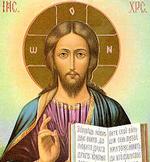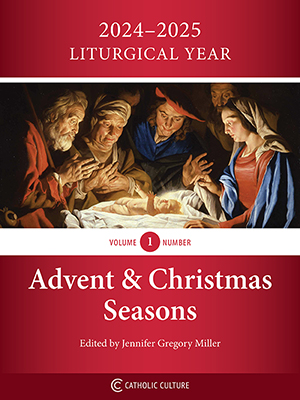Catholic Activity: Christmas Baking and Bread Blessing
Baking special Christmas Breads is a tradition that is found in almost all families all over the world. The baking is always done before Christmas, so this is technically an Advent activity that helps us prepare for Jesus, "Bread of Angels." The father or mother of the family can pray this blessing over newly baked Christmas bread.
DIRECTIONS
Christ, the Bread of Angels, has been honored by special "Christmas Bread" in every European country. Most delicious of these are Brioche or French Christmas bread, the German Christstollen whose criss-cross shape reminds us of the Child in swaddling clothes, and Melachrino or Greek spice cake. The latter our children call Hidden Jesus Bread, because of the Infant baked in it.
Brioche, a very light rich bread, is best mixed on Christmas Eve so the dough can stand before it is baked. Use a very hot oven on Christmas morning to make the dough rise quickly. The crust is crisp and brown, the center soft when the dough is handled lightly.
Early Christians brought their bread to the altar at the offertory procession. Some of it was used for the Sacrifice; the rest received a special blessing after the consecration, but was not changed into the Body of Christ. It was taken home as Blessed Bread. Whenever we attend the Byzantine Liturgy at Fordham's Russian Center, we take part in a similar custom.
The mother of the family may use her powers as a member of "the royal priesthood" to which St. Peter refers in his First Epistle. She may sprinkle holy water over the newly-made bread, and pray Holy Mother Church's official blessing:
Mother: Let us pray. Lord Jesus Christ, Thou the bread of angels, Thou the living bread of eternal life, graciously deign to bless this bread as Thou didst bless the five loaves in the desert that all who partake of it may have health of body and soul. Who livest and reignest for ever and ever. Amen.Eating blessed bread makes such an impression upon children that no scrap of it is ever wasted "because it is God's special food."
Christstollen needs plenty of room so that the shape of the Child in swaddling clothes will be surely seen in the folds of dough.
After we have received the Eucharistic Bread at Christmas Mass, we like a favorite sweet bread or spice cake which Mrs. Berger calls Melachrino. In Greece it is customary to hide a silver coin deep in its crust; we bake a tiny figure of the Holy Infant in the dough.
From the Italians comes a quick dessert for that busiest of days, Vigilia di Natale, the Vigil of Christmas. It is a Cassata or Cream Tart which may be made with store sponge cake to save time.
We go to great lengths in Christmas cooking, but there are two shortcuts which we take. One is the use of store cake in the Cassata above and the other the use of prepared mincemeat, and, on occasion, prepared pie crust.
Mincemeat pie at Christmas was originally made in an oblong baking pan to remind us of Christ's birth in a manger, while the richness of its ingredients and the spices remind us of the gifts of the Magi. We use a standard prepared mincemeat and a standard pastry recipe for a two crust pie. A 7x11 cake pan utilizes the dough and leaves enough scraps after the pie is trimmed for a pastry Infant Jesus. This is cut from a Nativity cookie cutter, baked separately and placed on the manger-pie. The gingerbread boy had Baby Jesus for his original model.
As Christmas approaches, the house smells of baking; presents are wrapped; and the wreaths are hung. The children unveil the Christ-Candle and set up their cribs. It is then that their Daddy covers the fireplace mantle with evergreens — Oregon holly when we can afford it — and centers a Madonna and Child with many vigil lights as the focus of the room. A spray of evergreen is placed across the top of every picture in the room; and a piece is wound around a huge white candle placed on the dinner table to symbolize the Light of the world for whom we have made these elaborate preparations. As is the Irish custom, the candle is lighted by the man of the house after the Angelus on Christmas eve.
Activity Source: Family Advent Customs by Helen McLoughlin, The Liturgical Press, Collegeville, Minnesota, 1954, 1979






